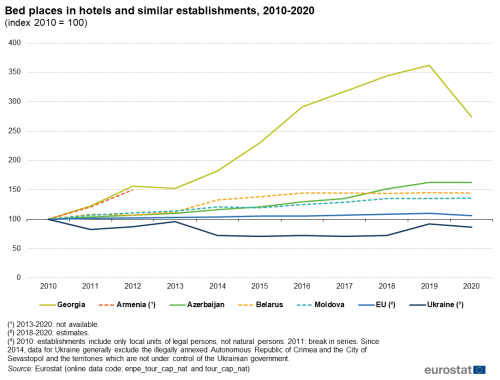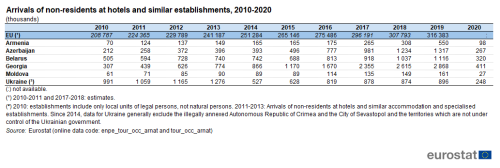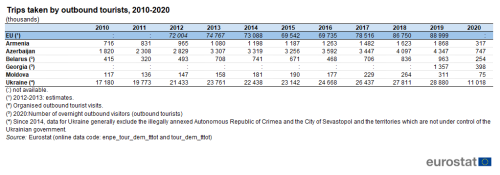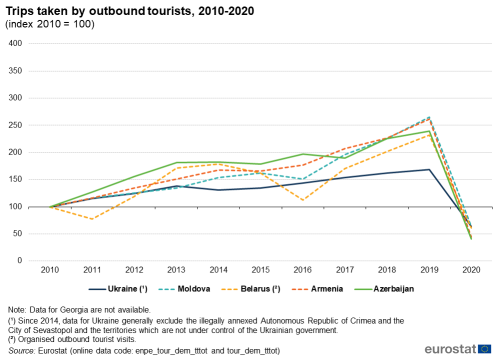Archive:European Neighbourhood Policy - East - tourism statistics
Data extracted in January 2022.
Planned article update: March 2023.
Highlights
There were more than 300 000 bed places in hotels and similar establishments across the European Neighbourhood Policy-East countries in 2020, compared with almost 12 million in the EU.
Aside from Ukraine, the number of bed places grew over the period 2010-2020 in all of the European Neighbourhood Policy-East countries for which data is available.
In 2020, the number of non-residents who arrived at hotels and similar establishments of the European Neighbourhood Policy-East countries fell by 80 %, compared with 2019.
Arrivals of non-residents at hotels and similar establishments, 2010-2020
This article is part of an online publication and presents information relating to tourism in the six countries that together form the European Neighbourhood Policy-East (ENP-East) region: Armenia, Azerbaijan, Belarus, Georgia, Moldova and Ukraine, compared with the European Union (EU). Data shown for Georgia exclude the regions of Abkhazia and South Ossetia over which Georgia does not exercise control and the data shown for Moldova exclude areas over which the government of the Republic of Moldova does not exercise control. The latest data for Ukraine generally exclude the illegally annexed Autonomous Republic of Crimea and the City of Sevastopol and the territories which are not under control of the Ukrainian government (see specific footnotes for precise coverage).
This article highlights recent developments concerning the number of bed places in hotels and similar establishments, the number of arrivals of non-residents at tourist accommodation establishments and the number of trips made by outbound tourists.
Tourism plays an important role in the ENP-East region because of its economic and employment potential, as well as its social and environmental implications. Tourism statistics are not only used to monitor tourism policies but also sustainable development policies at national and sub-national levels.
Full article
Tourism infrastructure
There were more than 300 000 bed places in hotels and similar establishments across the ENP-East countries in 2020; half of these were in Ukraine
The number of bed places available in hotels and similar tourist accommodation establishments provides one measure of a country’s capacity to attract tourists. Official tourism statistics include business travellers as tourists, alongside individuals travelling for pleasure or other reasons. In 2020, the six ENP-East countries had a combined total of 328 000 bed places (the latest information for Armenia refers to 2012). By comparison, there were 11.9 million bed places in hotels and similar establishments across the EU in 2020.

(thousands)
Source: Eurostat (enpe_tour_cap_nat) and (tour_cap_nat)
Among the ENP-East countries, Ukraine had by far the highest number of bed places in hotels and similar establishments, at 162 000 in 2020, corresponding to 49 % of the total number of bed places available within the six ENP-East countries (see Table 1). Note that the large fall between 2013 and 2014 in the number of bed places in Ukraine to a large extent reflects the change in geographical coverage of Ukrainian data, in particular the exclusion of the Autonomous Republic of Crimea, as well as the City of Sevastopol and a part of the temporarily occupied territories in the Donetsk and Luhansk regions. The second highest number of bed places among ENP-East countries was in Georgia, where there were 58 000 in 2020.
Aside from Ukraine, the number of hotel bed places grew in all of the ENP-East countries during the last decade
Figure 1 provides information on the development of the number of bed places in hotels and similar establishments over the period 2010-2020. Note that the data for Ukraine is influenced by a break in series in 2011 and a change in the geographical coverage in 2014. With the exception of Ukraine, all of the remaining ENP-East countries reported a marked expansion in their bed capacity during the period shown, with the number of bed places almost tripling in Georgia. For comparison, there was an overall increase of 6 % in the total number of bed places available across the EU in hotels and similar establishments between 2010 and 2020.
The year 2020 saw a global impact on tourism as a consequence of the COVID-19 pandemic. In Georgia, the number of bed places in hotels and similar establishments fell by 24 % from the previous year; in Ukraine, the decline was 6 %. The other three ENP-East countries that reported data showed a less than 1.0 % change (increase or decrease). In the EU, the 2020 figure was 3 % lower than in 2019.

(index 2010 = 100)
Source: Eurostat (enpe_tour_cap_nat) and (tour_cap_nat)
Non-resident arrivals
Some 1.4 million non-residents arrived at hotels and similar establishments in the ENP-East countries in 2020, down from 6.9 million in 2019
In 2020, there were 1.4 million arrivals of non-residents at hotels and similar establishments across the six ENP-East countries, compared with 6.9 million in 2019. The 2019 figure could be compared with a total of 316 million arrivals of non-residents at hotels and similar establishments in the EU (see Table 2; EU data is not available for 2020); non-resident arrivals in the six ENP-East countries were equivalent to 2.2 % of the EU total in 2019.
In 2020, Georgia had the highest number of non-residents arriving at hotels and similar establishments, with 411 000, followed by Belarus (320 000), Azerbaijan (267 000) and Ukraine (248 000). Armenia counted 98 000, while Moldova had 27 000 arrivals of non-residents.

(thousands)
Source: Eurostat (enpe_tour_occ_arnat) and (tour_occ_arnat)
Table 3 and the Highlights section graph show the development of the number of arrivals of non-residents staying in hotels and similar establishments during the period 2010-2020. Developments can clearly be divided into the periods 2010-2019 and 2019-2020.
During the period 2010-2019, there was a strong increase in the number of arrivals of non-residents in the six ENP-East countries, except for Ukraine where the number more than halved from 2013 to 2014 and was almost 10 % lower in 2019 than it had been in 2010. At least part of the reduction in Ukraine could be attributed to changes in the geographical coverage of the data from 2014 on. Among the other ENP-East countries, the fastest expansion in the number of arrivals of non-residents was recorded in Georgia, as the number of arrivals in 2019 was 9.4 times as high as it was in 2010. The pace of growth in non-resident tourist arrivals in Armenia was almost as fast, at 7.8 times as high in 2019 as in 2010. The increase was also considerable in Azerbaijan over 2010-2019, at 6.2 times. During this period, the number of non-resident tourist arrivals increased between two and three times in Belarus and Moldova. For comparison, the number of arrivals of non-residents in the EU increased by 52 % over 2010-2019.
The number of arrivals of non-residents staying in hotels and similar establishments fell sharply in all ENP-East countries in 2020, the first year of the COVID-19 pandemic, in comparison with 2019. In Georgia the decline was 86 %; in Moldova, 83 %; Armenia 82 %; Azerbaijan 80 %; Ukraine 72 %; and Belarus 71 %.

(index 2010 = 100)
Source: Eurostat (enpe_tour_occ_arnat) and (tour_occ_arnat)
Figure 2 shows the number of arrivals of non-residents at hotels and similar establishments relative to the number of (resident) inhabitants for 2010, 2019 and 2020. Among the ENP-East countries, Georgia had the highest ratio of non-resident arrivals, with 111 non-resident arrivals per 1 000 inhabitants in 2020, compared with 69 in 2010. There were 6 arrivals of non-residents per 1 000 inhabitants in Ukraine in 2020, compared with 22 in 2010. In Moldova the figures were 8 for 2020 and 17 for 2010. The impact of COVID-19 is clearly visible when comparing 2019 and 2020 data. The number of arrivals of non-residents at hotels and similar establishments relative to the number of (resident) inhabitants deceased by more than 70 % in all ENP-East countries, except in Belarus where it decreased by 40 %.

(per thousand inhabitants)
Source: Eurostat (enpe_tour_occ_arnat), (tour_occ_arnat) and (demo_pjan)
Outbound tourism
The number of outbound trips taken by tourists from Ukraine was 11.0 million in 2020, down from 28.9 million in 2019
This section details the outward flow of tourists travelling abroad.
Among the six ENP-East countries, the highest number of outbound tourist trips was recorded for Ukraine — the most populous of the ENP-East countries — at 11.0 million trips in 2020. There were 747 000 outbound trips made by tourists from Azerbaijan, 398 000 from Georgia, 317 000 from Armenia, 254 000 from Belarus (data refer only to organised trips) and 75 000 from Moldova (see Table 4).
EU tourists made 89 million non-domestic trips in 2019, the last year for which data is available; note that EU data for this particular indicator are estimates and only refer to persons aged 15 years or older.

(thousands)
Source: Eurostat (enpe_tour_dem_tttot) and (tour_dem_tttot)
Developments for the number of outbound tourist trips between 2010 and 2020 are shown in Figure 3. Once again, observed trends can be divided into the period from 2010 to 2019; and from 2019 to 2020.
During the period 2010-2019, there was a rapid expansion in the number of outbound tourist trips from Moldova, the number of outbound tourists in 2019 being almost 2.7 times as high as in 2010. For Armenia and Azerbaijan, there were also substantial increases, with their numbers of outbound tourists in 2019 at, respectively, 2.6 and 2.4 times as high as in 2010. The number of organised outbound visits made by tourists from Belarus fluctuated considerably between 2010 and 2019, but, overall, the number of such visits was 2.3 times as high in 2019 compared to 2010. For Ukraine there was a relatively steady but modest increase in the number of outbound tourist trips between 2010 and 2019, interrupted by a fall in 2014 (when there was a change in coverage of the data); overall the number of trips increased by 68 % between 2010 and 2019.
Between 2019 and 2020, the first year of the COVID-19 pandemic, the number of outbound tourist trips fell sharply in each ENP-East country: by 83 % in both Armenia and Azerbaijan, by 76 % in Moldova, by 74 % in Belarus and by 62 % in Ukraine. In all ENP-East countries for which data is available (no 2010 data for Georgia), outbound tourism was considerably lower in 2020 than it had been in 2010.

(index 2010 = 100)
Source: Eurostat (enpe_tour_dem_tttot) and (tour_dem_tttot)
Source data for tables and graphs
Data sources
The data for ENP-East countries are supplied by and under the responsibility of the national statistical authorities of each country on a voluntary basis. The data result from an annual data collection cycle that has been established by Eurostat. These statistics are available free-of-charge on Eurostat’s website, together with a range of additional indicators for ENP-East countries covering most socio-economic topics.
Tourism, in a statistical context, refers to the activity of visitors taking a trip to a destination outside their usual environment, for less than a year. It can be for any main purpose, including business, leisure or other personal reasons other than to be employed in the place visited. A tourist is a visitor who stays overnight (at least one night).
Within the EU, a system of tourism statistics was established through Council Directive 95/57/EC of 23 November 1995 on the collection of statistical information in the field of tourism. This legal basis requires EU Member States to provide a regular set of comparable tourism statistics. The Directive was amended in 2004 and 2006, before being repealed in 2011 when the European Parliament and the Council of the European Union adopted Regulation (EU) No 692/2011 concerning European statistics on tourism. The 2011 Regulation on tourism statistics was amended in 2013, in 2019 and again in 2020; the current consolidated version of Regulation (EU) No 692/2011 incorporate all these amendments.
Tourism statistics in the EU consist of two main components: on the one hand, statistics relating to capacity and occupancy (supply-side tourism statistics); on the other, statistics relating to tourism demand. In most EU Member States, the former data are collected via surveys filled in by accommodation establishments, while the latter are mainly collected via traveller surveys at border crossings or through household surveys. Statistics on tourism demand refer to tourist participation, in other words, trips of at least one overnight stay during the reference period.
Tables in this article use the following notation:
| Value in italics | data value is forecasted, provisional or estimated and is therefore likely to change; |
| : | not available, confidential or unreliable value; |
Context
Tourism has the potential to contribute towards employment and economic growth, as well as to the development of rural, coastal, peripheral or less-developed areas. Infrastructure created for tourism purposes contributes to local development, while jobs that are created or maintained can help counteract industrial or rural decline. Sustainable tourism involves the preservation and enhancement of cultural and natural heritage, ranging from the arts to local gastronomy or the preservation of biodiversity.
On 2 July 2021, the European Commission and the EU High Representative for Foreign Affairs and Security Policy presented the Eastern Partnership: a Renewed Agenda for cooperation with the EU’s Eastern partners. This agenda is based on the five long-term objectives, with resilience at its core, as defined for the future of the Eastern Partnership in the Joint Communication Eastern Partnership policy beyond 2020: Reinforcing Resilience – an Eastern Partnership that delivers for all in March 2020. It is further elaborated in the Joint Staff Working Document Recovery, resilience and reform: post 2020 Eastern Partnership priorities. It will be underpinned by an Economic and Investment plan. The Joint Declaration of the Eastern Partnership Summit ‘Recovery, Resilience and Reform’ of 15 December 2021 reaffirms strong commitment to a strategic, ambitious and forward-looking Eastern Partnership.
In cooperation with its ENP partners, Eurostat has the responsibility ‘to promote and implement the use of European and internationally recognised standards and methodology for the production of statistics necessary for developing and monitoring policy achievements in all policy areas’. Eurostat undertakes the task of coordinating EU efforts to increase the statistical capacity of the ENP countries. Additional information on the policy context of the ENP is provided here.
Direct access to
- All articles on non-EU countries
- European Neighbourhood Policy countries — statistical overview — online publication
- Statistical cooperation — online publication
- Tourism statistics
Books
Factsheets
Leaflets
- Basic figures on the European Neighbourhood Policy — East countries — 2020 edition
- Basic figures on the European Neighbourhood Policy — East countries — 2019 edition
- Basic figures on the European Neighbourhood Policy — East countries — 2018 edition
- Basic figures on the European Neighbourhood Policy — East countries — 2016 edition
- Basic figures on the European Neighbourhood Policy — East countries — 2015 edition
- Basic figures on the European Neighbourhood Policy — East countries — 2014 edition
- International trade for the European Neighbourhood Policy — East countries — 2016 edition
- European Neighbourhood Policy-East countries — Statistics on living conditions — 2015 edition
- European Neighbourhood Policy — East countries — Key economic statistics — 2014 edition
- European Neighbourhood Policy — East countries — Labour market statistics — 2014 edition
- European Neighbourhood Policy — East countries — Youth statistics — 2014 edition
- Industry, trade and services (enpe_ints)
- Tourism (enpe_tour)
- Industry, trade and services (enpe_ints)
- Tourism (tour), see:
- Monthly data on tourism industries (tour_indm)
- Annual data on tourism industries (tour_inda)
- Annual data on trips of EU residents (tour_dem)
- Eastern European Neighbourhood Policy countries (ENP-East) (ESMS metadata file — enpe_esms)
- Occupancy of tourist accommodation establishments (ESMS metadata file — tour_occ_esms)
- Annual data on trips of EU residents (ESMS metadata file — tour_dem_esms)
- Methodological manual for tourism statistics — version 3.1 — 2014 edition
- European External Action Service — European Neighbourhood Policy
- Joint Communication JOIN(2020) 7 final: Eastern Partnership policy beyond 2020: Reinforcing Resilience - an Eastern Partnership that delivers for all (18 March 2020)
- Joint Staff Working Document SWD(2021) 186 final: Recovery, resilience and reform: post 2020 Eastern Partnership priorities (2 July 2021)
- Joint Declaration of the Eastern Partnership Summit: ‘Recovery, Resilience and Reform’ (15 December 2021)